Where Terraces Abound, and Leafy Plants are Found
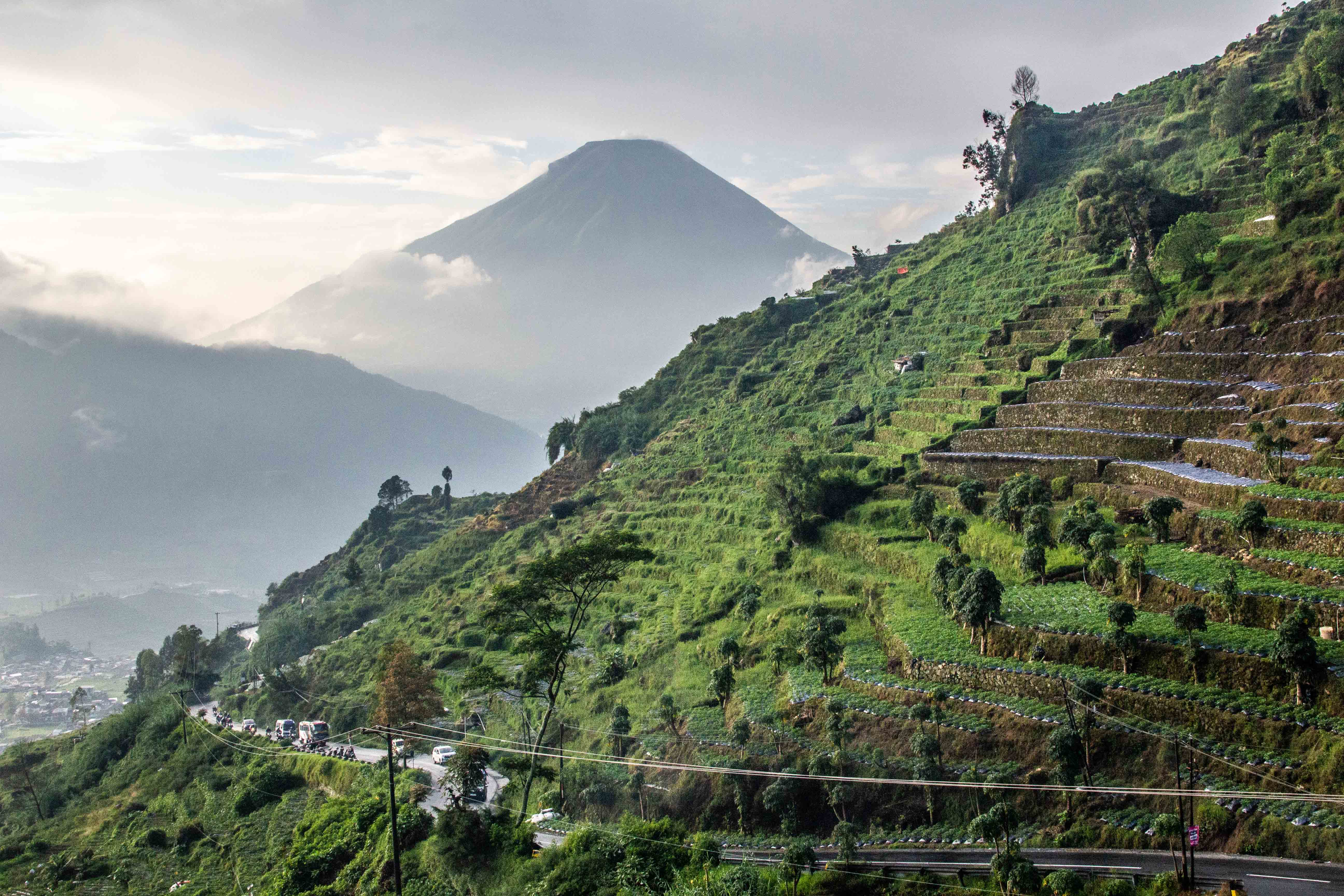
I've recently returned from a trip to Indonesia, aimed at:
- exploring parts of Java which I'd either not before visited, or not seen for many, many years;
- catching up with my extended family and friends; and
- viewing for myself how this most highly populated island in the world has changed since my previous visits.
For a country relying greatly on the production of rice, plus an assortment of fruit and vegetables, I have often been fascinated by how agriculture is not merely limited to the flatter coastal plains, but abounds on the many meticulously constructed terraces rising skyward on the steeper slopes surrounding the many volcanoes and caldera formations. Indeed I was advised that many of the coastal plains, where rice is grown, have proved unsuited to the sustenance of the more diverse crops we found elsewhere (presumably due to reduced fertility).
The attraction, of course, in living on and close to the steep sloping terrain throughout the inland areas of Java, is that volcanic origin soils are invariably very fertile, resulting in excellent crop yields, albeit necessitating some degree of slope management, drainage and erosion control. This attraction, for many farmers, appears to outweigh the often present threat of ash being expelled, or burning lava flowing, from one or other of the 45 odd active volcanoes on Java, a few of which erupt with a certain degree of regularity. Mt Merapi, near Yogyakarta, and Mt Semeru and Mt Kelud, both in East Java, are reportedly the most active in Java (Ref 3).
A much greater abundance of paddy (the name given to rice while in the ground as a crop, prior to husking and drying) is evident on the coastal plains.
![y iu bre f
RA A va
A p dr y "
- sy Ee § ‘
J gb A $ POPS Y J J 2 "31 JRO ALR S47 ARE
a ud i i 4 REAR y f 3 1} J hans Eon ata ' i M £4 ; 3
) Hi 3s J b adie ola TY : :
| / , ’ » [YEH E TL Ae 52
If Is f | i 5
| ) ‘
[] ¢ | g ; |
' \ 4 A ! |
) \ | f ; { \ |
| U ) | |
| Aud !
) () | |
2p Jl
s { | JV ) Wid
\ i 1 i! Li](https://contents.bebee.com/users/id/11299405/article/where-terraces-abound-and-leafy-miHJ2yQ637YD/hYNrh.jpg)
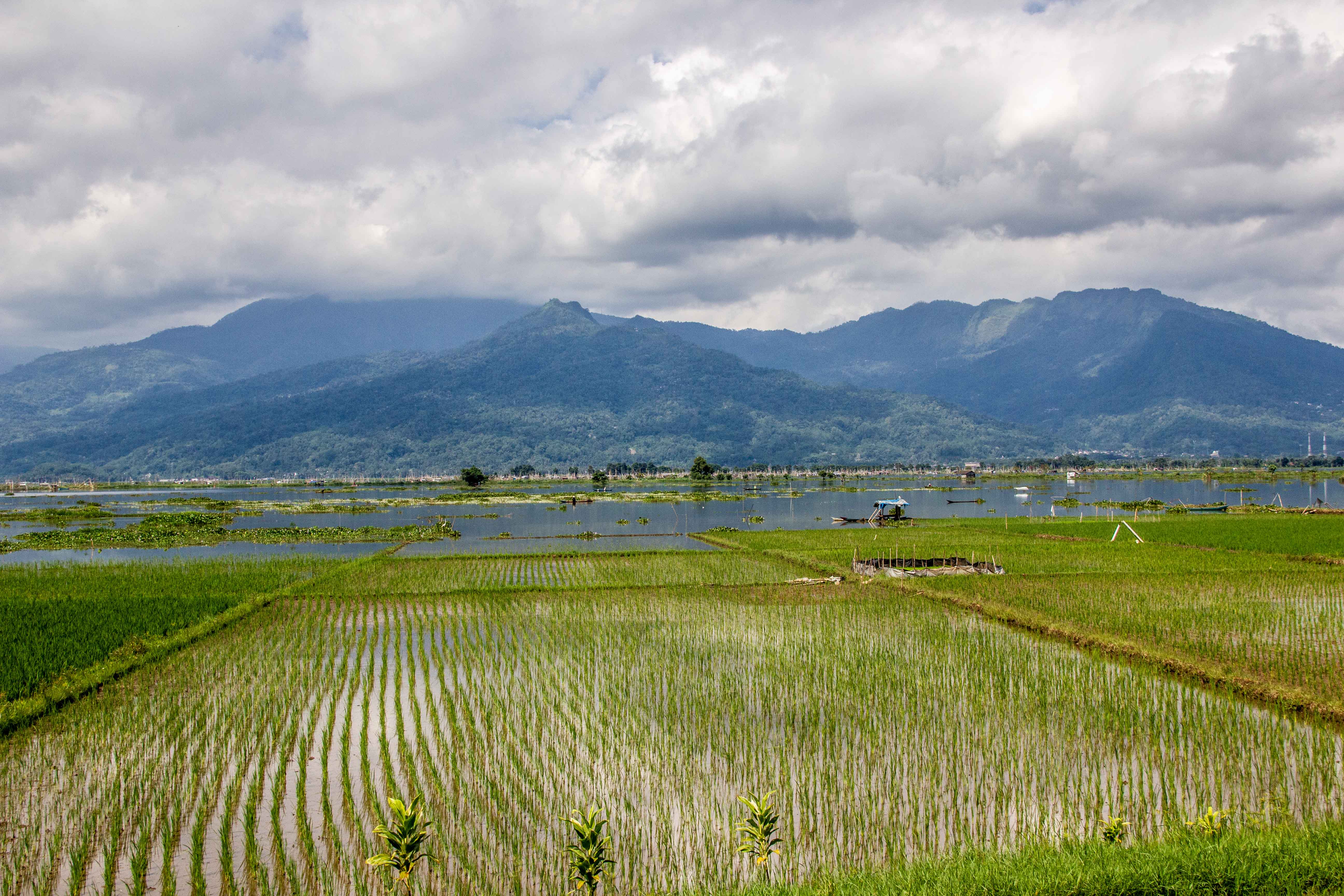
[The above two photos show paddy fields on the edge of Lake Rasa Pening, near Salatiga, Central Java, with Mount Merbabu trying to peep through the rain clouds on the distant left]
These paddy fields often extend impressively for miles in all directions in the relatively open land between population concentrations, but are also found in urban areas in vacant individual lots, no doubt providing a challenge to property developers due to the waterlogged nature of this land and the associated underlying soft soil.

[Smaller paddy fields on the outskirts of Ambarawa, Central Java]
Many tourists are taken by tour guides to ‘rice terraces’ in Bali, at beautiful locations such as Tegalalang [see photo below], but these, although impressive in their own way, are much less grand than some of the many crop terraces we visited in more remote parts of Java.
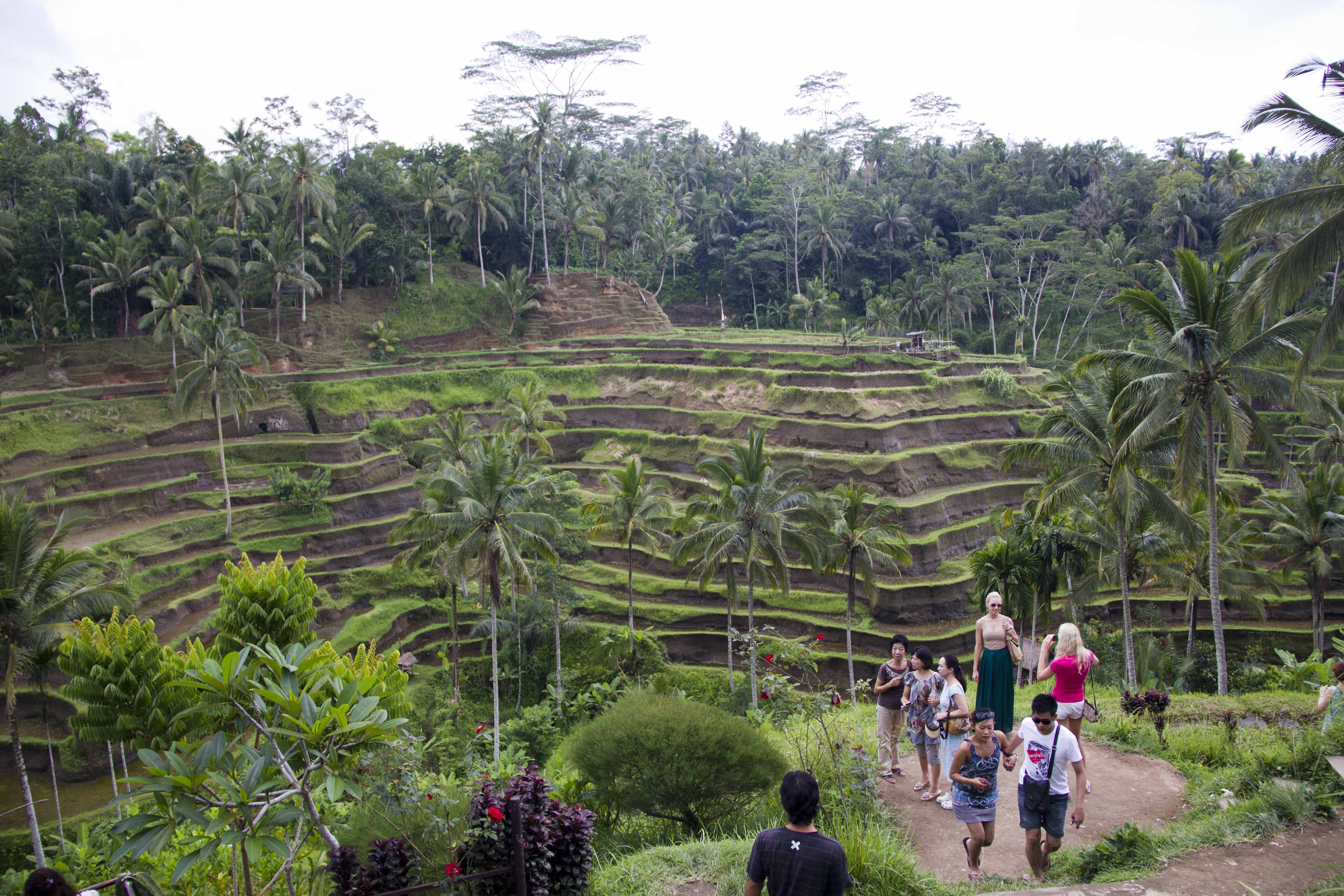
This time round, the area where we experienced the most impressive crop terraces, in terms of their overall height and steepness of the slopes on which they had been constructed, was in Plateau Dieng. This is located approximately 50km (as the crow flies) west-south-west of Semarang. This impressive area is located within the confines of a large volcanic complex, some 6km by 14km in area and housing, reportedly (Ref 1), two or more stratovolcanoes and twenty of more smaller craters and volcanic cones. The above title photo to this blog and the following photos were taken on and around the steep terraced slopes of Dieng.

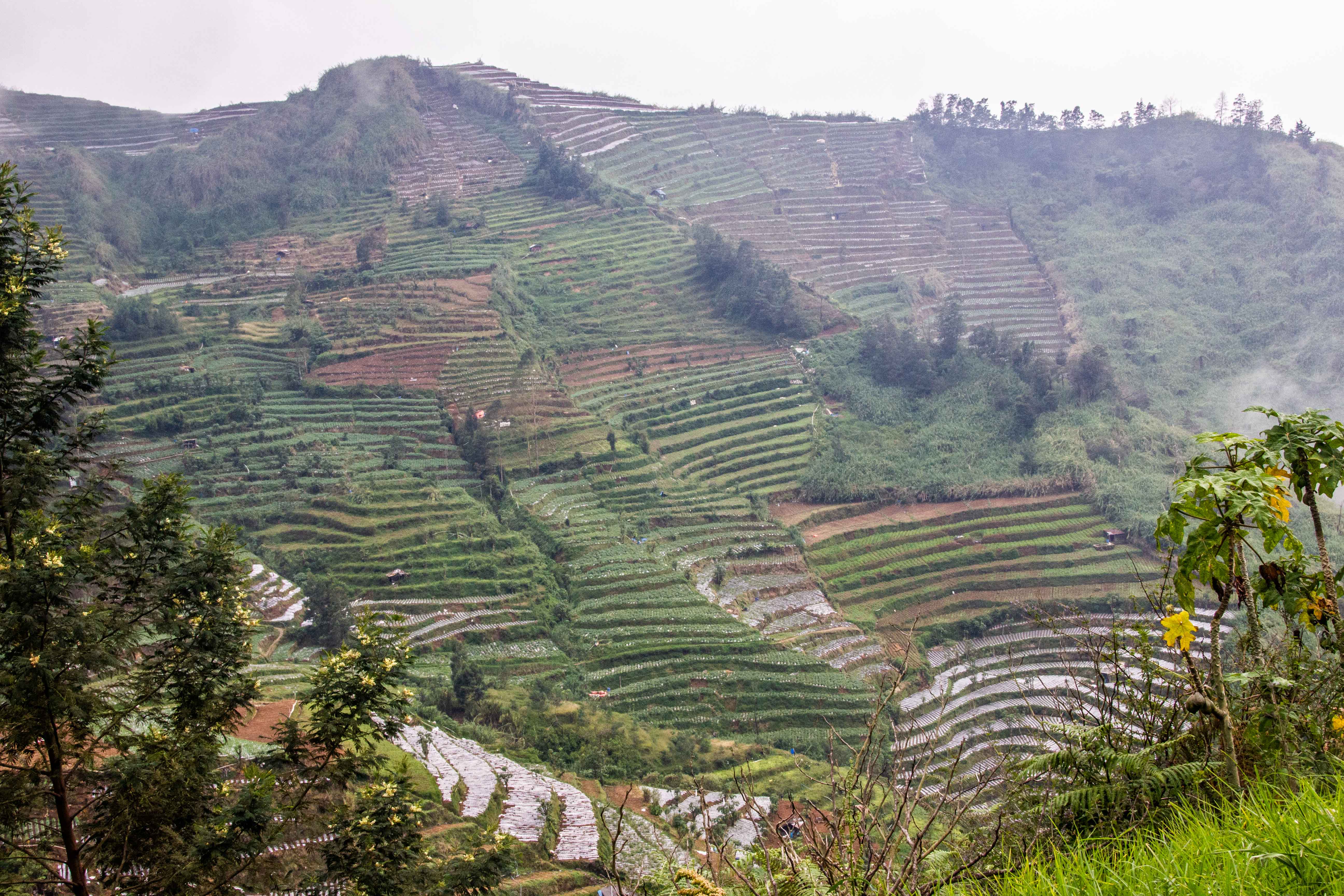

It seems that Dieng is one of the largest producers of potatoes in Indonesia (Ref 2), although we also noticed crops of chile, and more isolated clumps of paw paw (papaya) and carica (pronounced chareecha), a fruit, similar to but smaller than papaya, which is locally made into a popular fruit drink ('minuman buah') illustrated in the photo below.
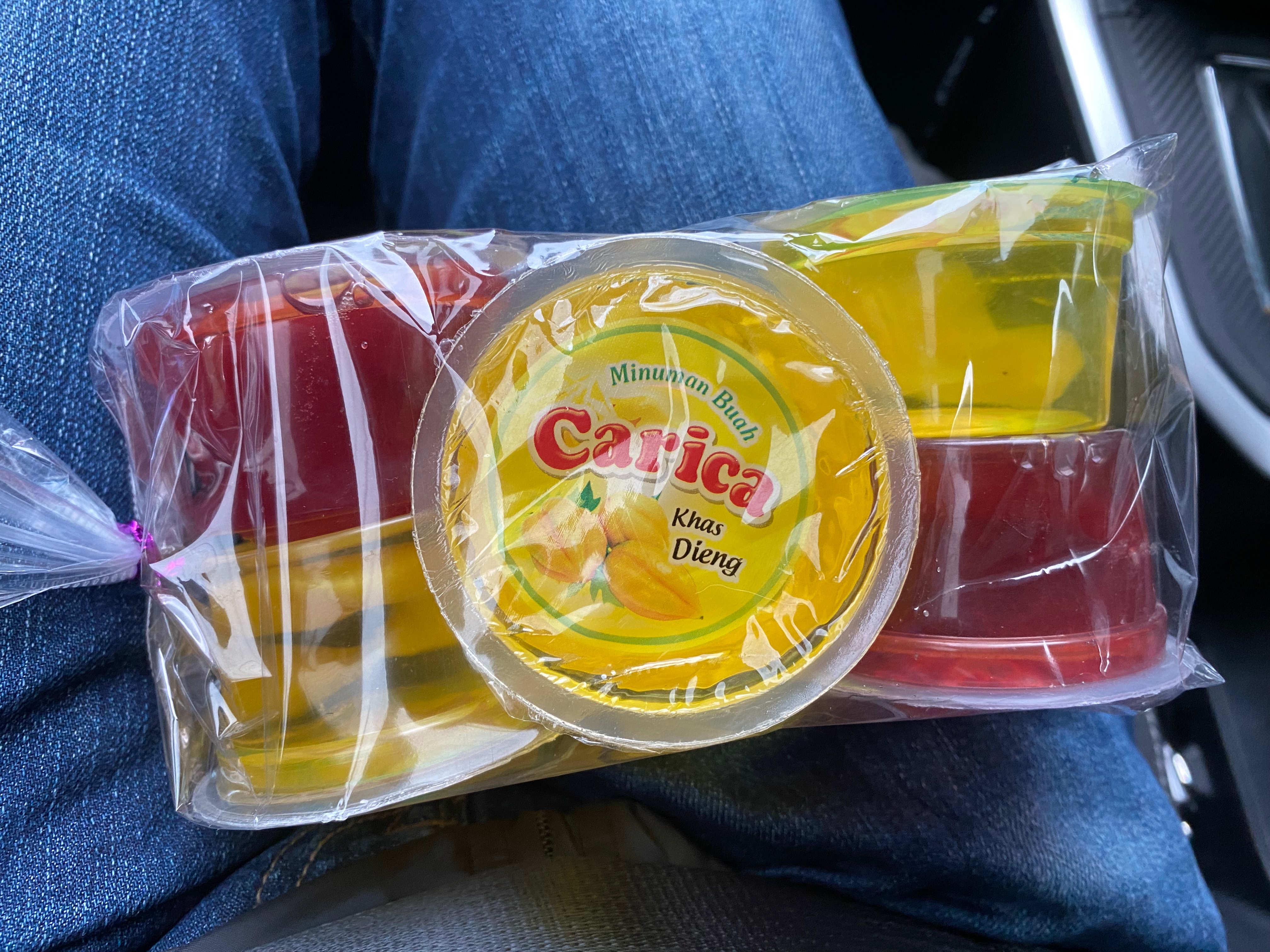
It was obvious to the trained eye (I am a retired geotechnical engineer) that the terraced terrain, road cuttings, and steeper land adjacent to streams, had been subjected to localised landslip and erosion. This is substantiated in an article published in the Jakarta Post (Ref 4), now a bit dated (published in October 2015). The photo below indicates a very recent shallow landslip (undergoing remediation) on the main access road into Dieng. Here I should mention that we visited at the end of the rainy season.
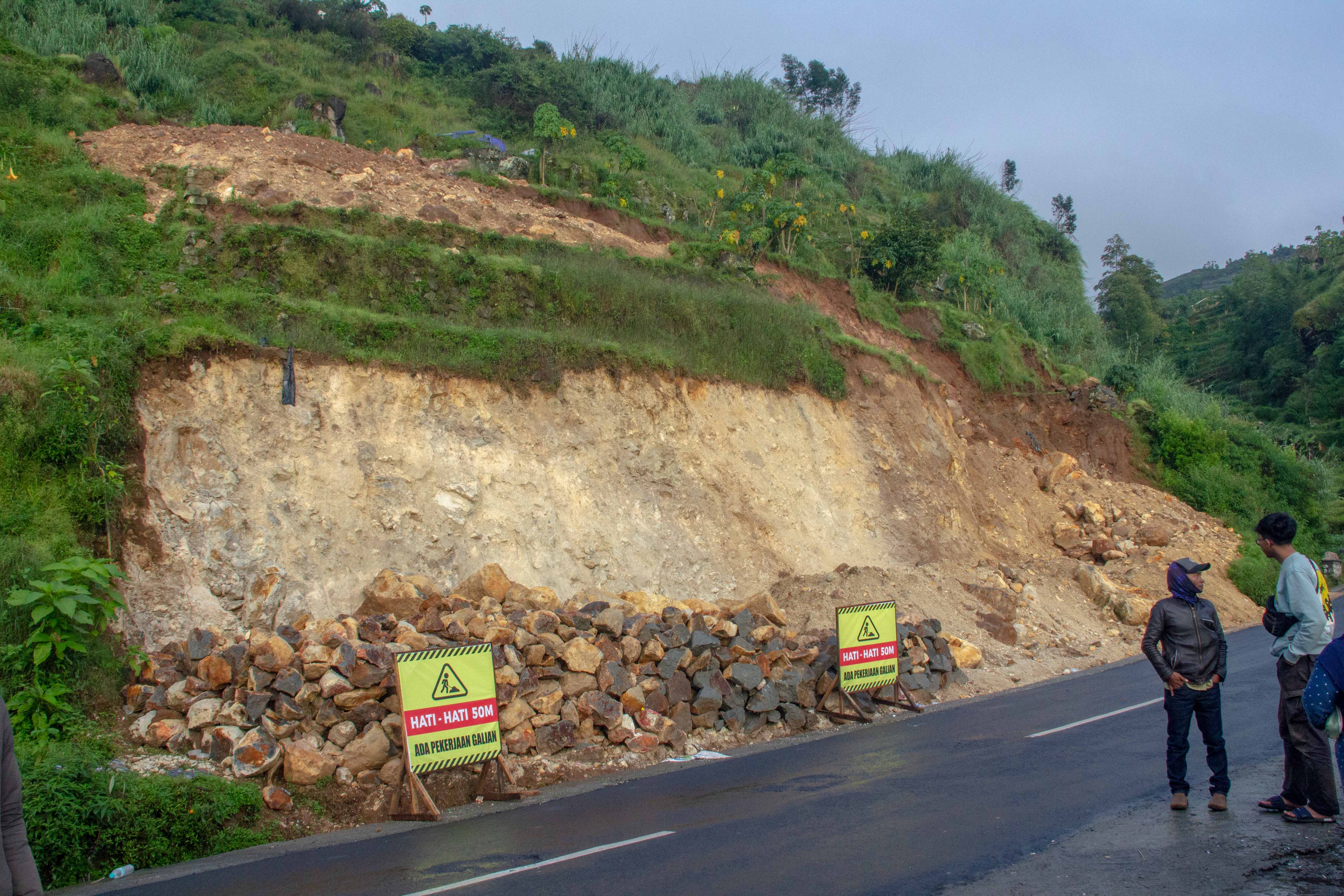
It appeared that steps were currently being taken, as evident in some of the above photos, to attempt to control soil erosion and land slippage in many of the terraced areas we visited. These included the use of:
- geotextile sheets across some of the terrace flats, to minimise rilling erosion and intensive rainfall infiltration, while also keeping weeds down;
- white PVC pipes to convey water from upper to lower terraces; and
- coarse gravel and cobble sized stone facing, to assist in supporting some of the near vertical terrace cuts (only evident in a minority of cases, possibly following slippage problems, and presumably due to a limited local availability of such materials).
Another crop that has fascinated me for many years is tea, and Indonesia is reportedly the world's seventh largest producer, exporting most of what it produces (Ref 5). Furthermore, the main production areas are in West Java (the largest and located in high ground generally between Bandung and Bogor), Central Java (near Dieng, one of the main focal points of our trip), and North Sumatra (Ref 6).
In Indonesia, tea is often poured from fired clay teapots into matching cups and saucers, with rock sugar served on the side, and both my wife and I have enjoyed many a ‘cuppa’, so poured, during our many visits to ‘Indo’. Indeed, we noticed many of these basic clay tea sets for sale in Cirebon, on the north coast of Central Java, west of Semarang. Cirebon is a well known producer of pottery and is also famed for its own patterns of batik clothing. Moving back to tea, “Indonesia produces a wide variety of teas including organic delicate silver needle, oolong, jasmine tea and vibrant imperial black tea” (Ref 6).
As we drove south from the Dieng Plateau towards the lower slopes north of Wonosobo, we took a planned diversion to visit the famous Tambi Tea Gardens. As it happened, our visit coincided with a public holiday when the estate was formally closed. The gift shop and restaurant were open, however, and so, after a hearty breakfast, we managed to arrange for an unofficial tour (many things are possible in ‘Indo’, where politeness and a few light-hearted jokes often see doors opening in this land of ‘rubber time’).
The following photos were taken in the Tambi Tea Gardens plantation, which has the imposing Mount Sundoro as a backdrop, when the rain clouds are not blanketing the area.
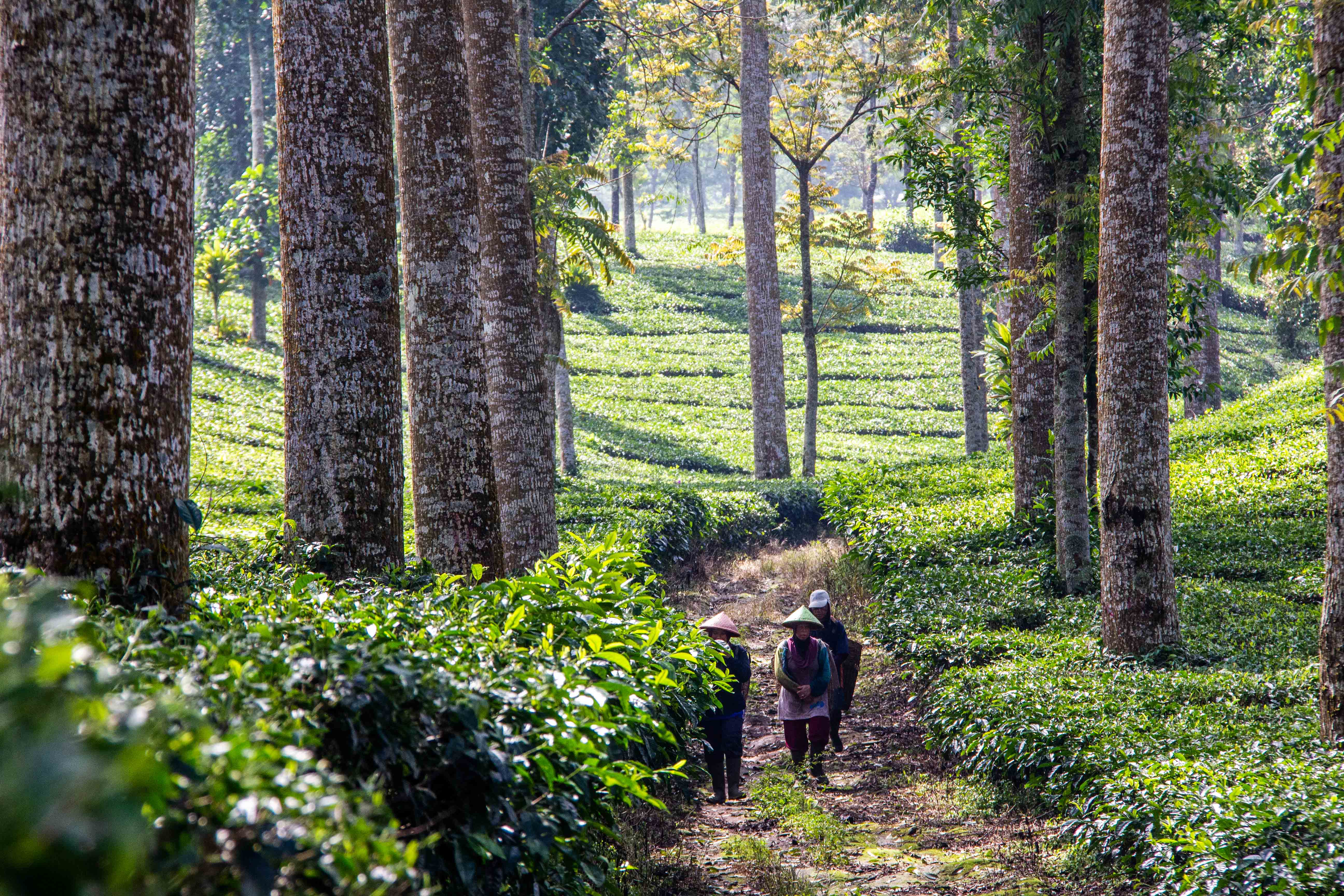
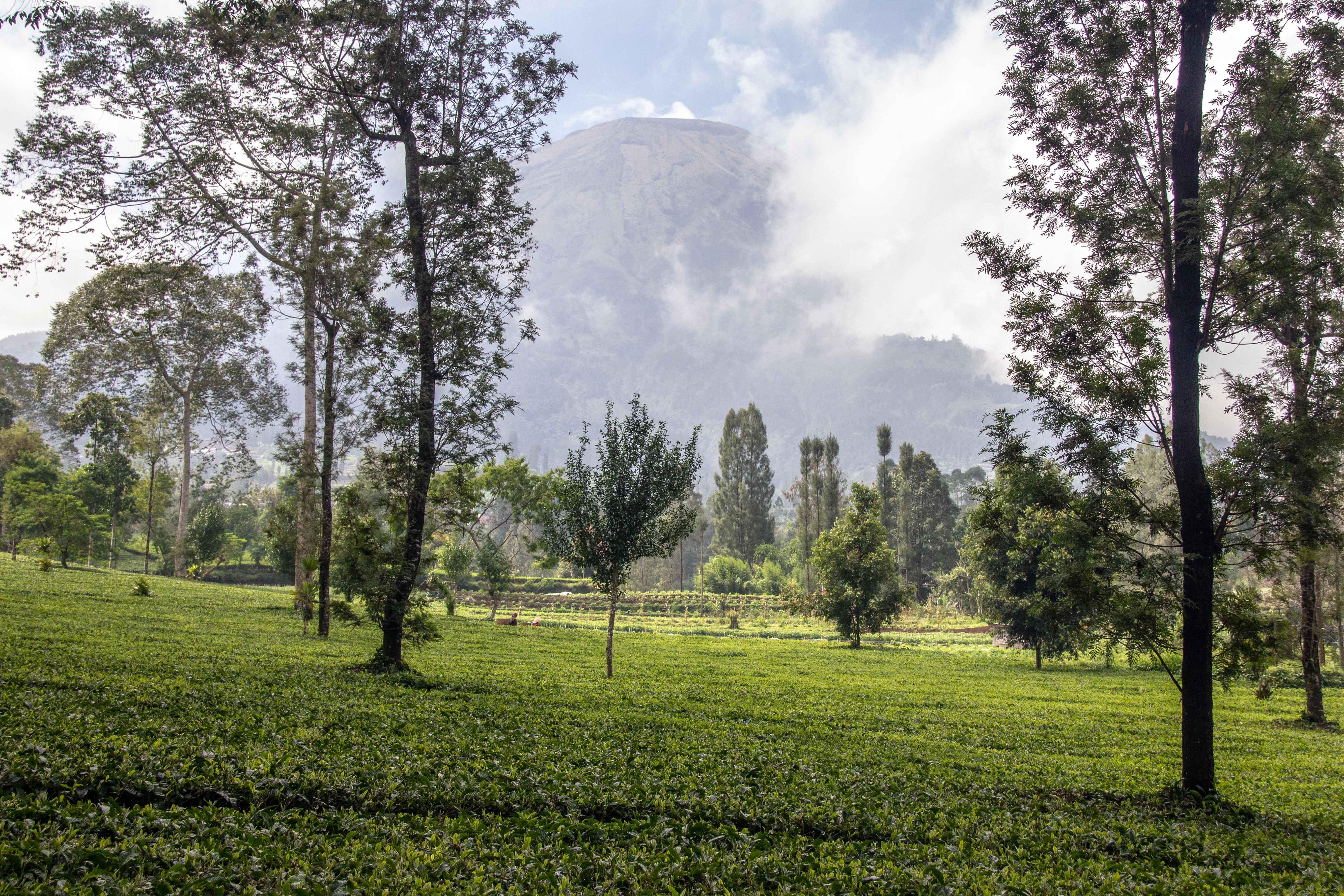

Only the tips of the new growth tea plants are actually cut for tea production (see photo below, which also features my wife's delicate left hand).
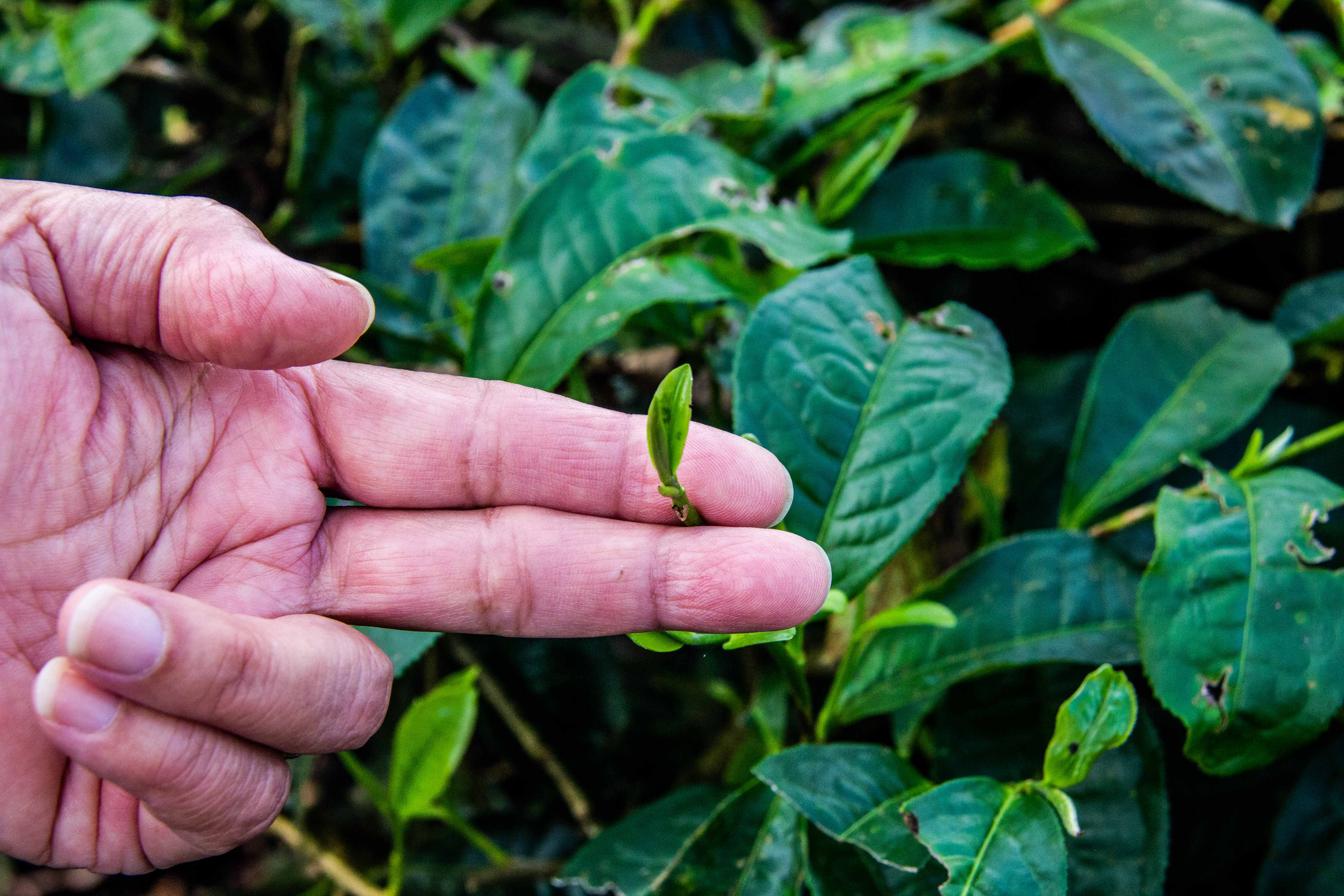
So let's leave the land of tea with a reminder that tea demands a certain degree of cooler air combined with lots and lots of rain.
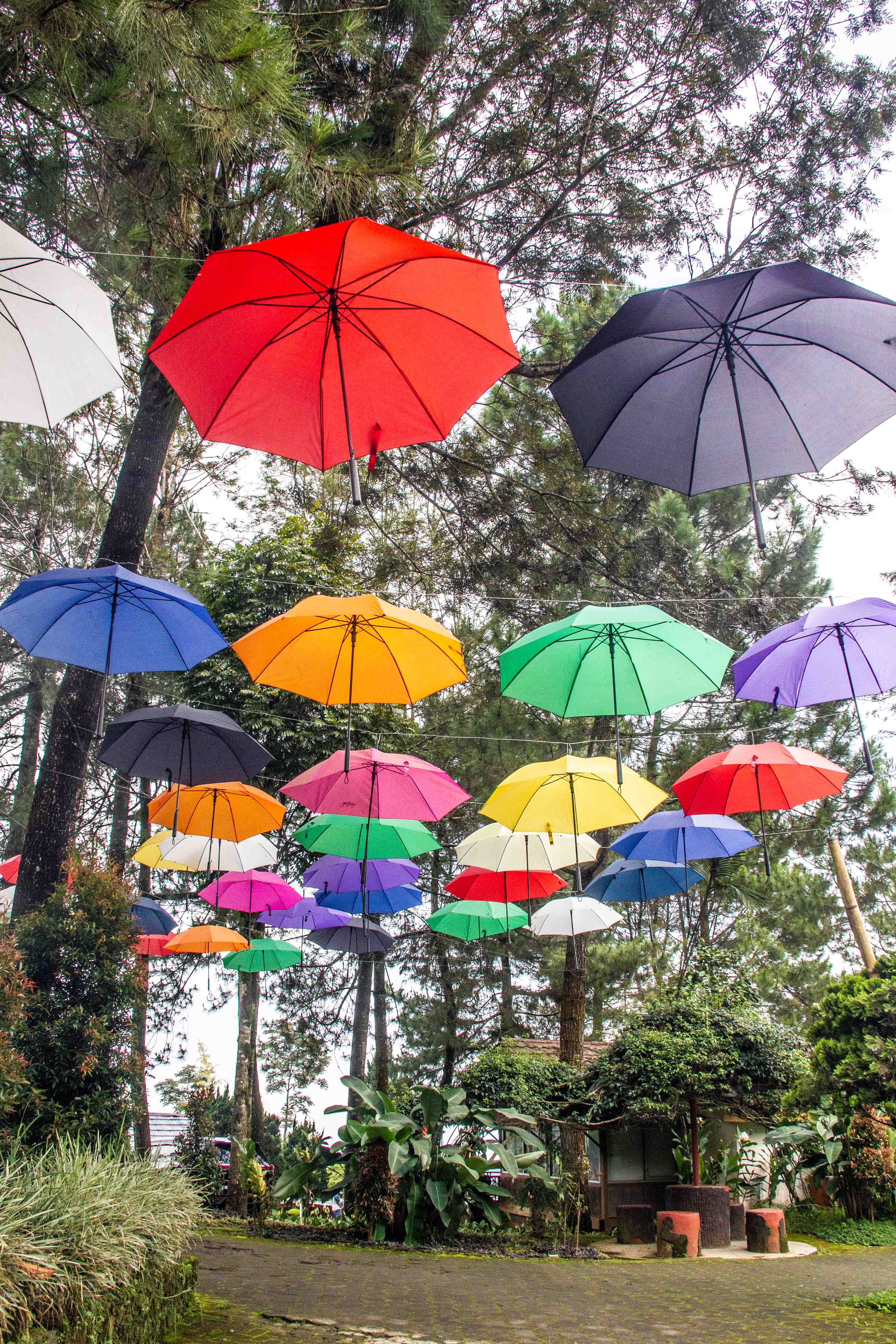
[A picture paints a thousand words :)]
References:
- https://en.wikipedia.org/wiki/Dieng_Volcanic_Complex#:~:text=The%20Dieng%20Volcanic%20Complex%20(Javanese,to%20Holocene%2Dage%20volcanic%20cones.
- https://en.wikipedia.org/wiki/Dieng_Plateau#:~:text=Farmers%20walk%20to%20their%20fields,and%20tobacco%20were%20planted%20instead.
- https://en.wikipedia.org/wiki/List_of_volcanoes_in_Indonesia#:~:text=Mount%20Merapi%2C%20Semeru%20and%20Kelud,been%20continuously%20erupting%20since%201967.
- https://www.thejakartapost.com/news/2015/10/20/dieng-plateau-potatoes-cultural-heritage.html.
- https://www.statista.com/statistics/1299339/indonesia-export-value-of-tea-by-type/#:~:text=Indonesia%20is%20currently%20the%20world's,exports%20most%20of%20its%20production.">https://www.statista.com/statistics/1299339/indonesia-export-value-of-tea-by-type/#:~:text=Indonesia%20is%20currently%20the%20world's,exports%20most%20of%20its%20production.
- https://www.coffeecartel.com.au/product-category/single-origin-teas/indonesia-origin/#:~:text=The%20main%20areas%20for%20tea,%2C%20tearing%2C%20curling)%20tea.

When not researching the weird or the wonderful, the comical or the cultured, the sinful or the serious, I chase my creative side, the results of which can be seen as selected photographs of my travels on my website at:
https://ken-boddie.squarespace.com
The author of the above, Ken Boddie, besides being a sometime poet and occasional writer, is an enthusiastic photographer, rarely leisure-travelling without his Canon, and loves to interact with other like-minded people with diverse interests.
Ken's work week (retired engineer), as a part-time or freelance English teacher to migrants, allows him to follow his photography interests, and to plan trips to an ever increasing list of countries and places of scenic beauty and cultural diversity.
Travelin Café beBee and in 1 more group
Articles from Ken Boddie
View blog
I've been busier than a mozzie (mosquito) at a nudist beach lately, so I haven't made time to write ...

Question No 1: Where can you find Roller Coasters, Hollywood Stunt Driving, The Batmobile, Speedy Go ...

I've been sleep deprived lately, so I thought I'd run around the bed several times to catch up on my ...
Related professionals
You may be interested in these jobs
-
Direct apply
Sharky Sports Aspley, AustraliaLooking for an assistant coach to help run a non-competitive soccer program for kids. · $35 per hour. Would suit high school student or someone looking for an hour after school and 2.5 hours on Saturday mornings. · Classes run from Aspley, Boondall and McDowall State Schools. · C ...
-

Barber
1 week ago
Direct apply
JTs Ladies & Mens Hairstylists Belmont Ellenbrook, AustraliaJts Ellenbrook currently has Casual positions available for Senior Barbers, if you are currently looking for a new salon we would love to hear from you. · With 5 salons located in major shopping centres across Perth (Belmont, Midland, Rockingham, Joondalup & Ellenbrook), Jts succ ...
-

Retail Wine Specialist
1 week ago
Direct apply
Somm Wine Store Mermaid Beach, AustraliaSOMM WINE STORE is an independent Wine Store located in Mermaid Beach, Queensland. · With a focus on small producers, we have an uncompromising commitment to offer an incredible range of wines from Australia and many wine regions around the world. · We are looking for professiona ...

Comments
Neil Smith
1 week ago #9
And now that's two things I learned. 👍
Ken Boddie
1 week ago #8
Glad you enjoyed reading this post, Neil. BTW, as you probably know, I just can’t resist being pedantic, and therefore Java, not Indonesia, is the most densely populated island. Indonesia is an archipelago of some 17,508 islands, based on recent Landsat satellite imagery. 🤗
Neil Smith
1 week ago #7
That Indonesia is the most densely populated island in the world, is today's thing that I learned. Thanks for an interesting post, Ken.
Ken Boddie
1 week ago #6
Thanks, Pascal. Good to have you read my post.
Pascal Derrien
1 week ago #5
Another great photo reportage from the one and only Ken Boddie
Ken Boddie
1 week ago #4
Thanks, Jerry. Remember that Java is the most densely populated island in the world. Sometimes the only way to go is up. ☝️
Jerry Fletcher
1 week ago #3
Ken, thank you for an enlightening article about a part of the world I'll probably never see. Isn't it amazing what humans will do and where they will live to scratch out a living! Oregon, where I live, is full of calderas but not a terrace to be seen.
Ken Boddie
1 week ago #2
Glad you enjoyed my tale of green plants and tea tips, Rob. This blog, of course, represents only the tip of our trip. I hope to write more on other matters in due course. Good to hear from you.
Robert Cormack
1 week ago #1
Really liked this, Ken. What a trip! Being tea drinkers, we'd probably set up right there in the fields and have a brew. Great pictures, by the way, and great descriptions. You really need a geological engineer to make sense of it all. I can't believe they have so many active volcanos.